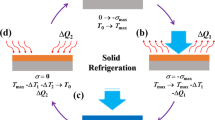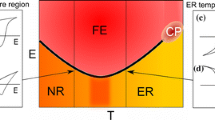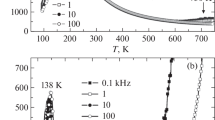Abstract
Based on a phenomenological model, the electrocaloric effects accompanied with the ferroelectric to paraelectric phase transition in relaxor ferroelectric 0.9PbMg1/3Nb2/3O3–0.1PbTiO3 thin film were investigated. The model reproduces the essential features of the experimentally observed behavior and also gives a description of the electric field dependence of the electrocaloric effect. The simulated results reveal many intriguing features of electrocaloric effect including electrocaloric entropy changes, heat capacity changes and temperature changes as functions of temperature due to different electric fields shifts ΔE. A relative cooling power and refrigerant capacity due to applied electric field shift were calculated.
Similar content being viewed by others
Avoid common mistakes on your manuscript.
1 Introduction
The electrocaloric effect (ECE) and magnetocaloric effect (MCE) have great importance for application in solid-state cooling devices in the past ten years [1–13]. The ECE may provide an efficient mean to realize solid-state cooling devices for a broad range of applications such as on-chip cooling and temperature regulation for sensors and electronic devices, provided that materials with large ECE can be developed [14]. In general, a large ECE requires a large entropy variation associated with the polarization change, so the ferroelectric materials, which are capable of generating large polarization change, have been considered as appreciable candidates.
Relaxor ferroelectrics could be attractive for cooling applications. Without a doubt, many relaxor films for example 0.9PbMg1/3Nb2/3O3–0.1PbTiO3 (0.9 PMN–0.1 PT) show pronounced pyroelectricity, suggesting that the converse ECE effect is physically powerful [15, 16]. Moreover, phase transition in relaxor is broad. The PMN–PT family, based on the relaxor PMN, has already been proposed for many applications [18–24]. The PMN-rich relaxors, and compositions near the morphotropic phase boundary at 0.65 PMN–0.35 PT, are promising for capacitors due to their large dielectric constant, and also for high-strain actuators/transducers and prototype microelectromechanical systems due to their piezoelectric properties [25].
Bulk 0.9 PMN–0.1 PT is a rhombohedral relaxor ferroelectric at room temperature [25, 26]. On heating above T C =60 °C, this structure transforms to a cubic paraelectric phase [25, 26]. The pyroelectric properties of PMN ceramics under high dc bias fields up to 100 kV cm−1 have been studied for thermal IR detector applications [17].
In this paper, dependence of polarization on variation of temperature for 0.9 PMN–0.1 PT thin film at different electric fields is simulated. This simulation is allowed me to predict electrocaloric properties under applied electric field shift ΔE (defined as E 2–E 1). It is used a phenomenological model for describing dependence of polarization on temperature variation to predict electrocaloric properties such as entropy changes, heat capacity changes, temperature changes, and relative cooling power.
2 Theoretical considerations
According to the phenomenological Hamad model [27], the dependence of polarization on variation of temperature and Curie temperature T c is presented by
Here P i is an initial value of polarization at ferroelectric-paraelectric transition and P f is a final value of polarization at ferroelectric-paraelectric transition as shown as Fig. 1.
B is polarization sensitivity \(\frac{dP}{dT}\) at ferroelectric state before transition, \(\frac{dP}{dT} |_{T = T_{C}}\) is polarization sensitivity \(\frac{dP}{dT} \) at Curie temperature T c and
Dependence of polarization as a function of temperature is described by Eq. (1)
A result of this model, the electrocaloric entropy change ΔS E caused by variation of the external electric field from E 1 to E 2 is given by
Equation (2) is determined by the physical mechanism that the dipole-ordered state can be enhanced by decreasing temperature. At transition temperature, the spontaneous polarization forms surface charges and stray charges accumulate on the surface of ferroelectric material. When there is non-homogeneous distribution of the spontaneous polarization, the surface charge produces an electric field, denoted as depolarization field which is in the opposite direction to the spontaneous polarization.
From Eq. (2), it is clear that the entropy change increases with an increase of polarization sensitivity \(\frac{dP}{dT}\) and it has a maximum value at T c .
A main result of Eq. (2) is maximum entropy change \(\Delta S_{\mathrm{Max}}^{E}\) (where T=T c ) can be expressed as following expression
Equation (3) is important equation for taking into consideration the magnitude of entropy change to evaluate cooling efficiency with its full-width at half-maximum.
According to this model, a full-width at half-maximum δT FWHM can be calculated as it follows [27].
From Eq. (4), it is clear that a full-width at half-maximum δT FWHM decreases with increasing polarization sensitivity \(\frac{dP}{dT}\) at T c and/or decreasing the difference (P i −P f ). An electrocaloric cooling efficiency is calculated by considering magnitude of maximum electrocaloric entropy change, \(- \Delta S_{\mathrm{Max}}^{E}\) and its full-width at half-maximum (δT FWHM) [28]. A product of \(-\Delta S_{\mathrm{Max}}^{E}\) and δT FWHM is called relative cooling power (RCP) based on electrocaloric entropy change.

A polarization-related change of heat capacity is given by
According to the model, a change of heat capacity is given by

A temperature change of a polar system under adiabatic electric field variation from an initial value E 1 to final value E 2 can be written in the form

Here ρ is a mass density of sample and C E is a heat capacity per mole at constant electric field.
The refrigerant capacity (RC), that is, the amount of heat that can be transferred in one thermodynamic cycle [29], which also takes into account the width and shape of ΔS E versus T curve, is a more relevant parameter when evaluating the technological interest in a refrigerant material. Conciliation between the peak entropy change and the width of the peak is necessary for a working prototype, as discussed by Wood and Potter [29].
Here, RC values can be obtained as it follows [27].

From this phenomenological model, it can easily calculate the values of δT FWHM, |ΔS E|Max, |ΔT|Max, RCP, RC, and ΔC Min for 0.9 PMN–0.1 PT thin film due to applied electric field shift ΔE.
3 Simulation
In order to apply phenomenological Hamad model, five parameters versus applied electric field were determined as displayed in Table 1. A heat capacity C E =120 J mol−1 K−1 (320 J Kg−1 K−1) and mass density ρ=8.08 g cm−3 for 0.9 PMN–0.1 PT thin film as in Ref. [2, 30, 31]. Figure 2 shows polarization versus temperature for 0.9 PMN–0.1 PT thin film under different electric field versus temperature, considering E 1=0. The symbols represent experimental data from Ref. [2] and the dashed lines represent simulated data. Figure 2 shows a good agreement between simulated results and experimental data. Figures 3, 4, 5 illustrate predicted entropy changes, heat capacity changes and temperature changes due to different electric fields shifts versus temperature calculated from Eqs. (2), (7) and (8) respectively.
Absolute values of electrocaloric entropy changes versus temperature due to applied electric field shift 0.9 PMN–0.1 PT thin film. They are obtained by Eq. (2) at different electric field shifts
Heat capacity changes for 0.9 PMN–0.1 PT thin film due to applied electric field shift ΔE versus temperature. They are obtained by Eq. (7) at different electric field shifts
Electrocaloric temperature changes ΔT due to applied electric field shift ΔE versus temperature for 0.9 PMN–0.1 PT thin film. They are obtained by Eq. (8) at different electric field shifts
It is clear that as the temperature is far away the Curie temperature, the entropy change with increasing temperature is not very noticeable, so the EC temperature change ΔT is small. When the temperature rises to close to T C , the large entropy change is induced by an external strong electric field during the ferroelectric–paraelectric phase transition, so ΔT becomes large. When the temperature is above and far from T c , due to the presence of only paraelectric phase, a small entropy change with rising temperature decreases ΔT sharply. This is why a large EC effect and the peak of ΔT occur near the Curie temperature, as shown in Fig. 5. Furthermore, the entropy change curves reveal the characteristics of the dipole reorientation by the kinks in the ΔS E curves. The maxima observed in the ΔS E curve are associated to a dipole reorientation that occurs continuously. Therefore, the behavior of ΔS E suggests how to extend the range of temperatures for use in the ECE.
Table 2 shows calculated values of δT FWHM, |ΔS E|Max, |ΔT|Max, RCP, RC, ΔC Min and ΔC Max for 0.9 PMN–0.1 PT thin film due to applied electric field shift ΔE. It is clear that as ΔE increases, the values of |ΔT|Max, |ΔS|Max, RCP, −ΔC Min and ΔC Max increase. This is a result of an increase of polarization change as reaction of an increase of ΔE. However, the value of δT FWHM and RC decrease as ΔE increases. This is attributed to different trends of changes in electric polarization and lattice elastic energy under ultrahigh electric field. Since the ultrahigh electric field induces larger lattice deformation.
4 Conclusion
Phenomenological Hamad model has been able to describe the ferroelectric–paraelectric transition 0.9 PMN–0.1 PT thin film under applied electric fields. The good agreement of this model with experimental data clarifies the suppleness of this model under a variety of applied electric fields. Qualitative agreement affirms that this model is useful for the prediction of the electrocaloric entropy changes, heat capacity changes and temperature changes due to applied electric field shift ΔE as a function of temperature. This may open more opportunities for practical application in refrigeration devices especially in the selection of materials and the refrigeration designs.
References
Neese, B., Chu, B., Lu, S., Wang, Y., Furman, E., Zhang, Q.M.: Science 321, 821–823 (2008)
Mischenko, A.S., Whatmore, R.W., Zhang, Q., Scott, J.F., Mathur, N.D.: Appl. Phys. Lett. 89, 242912 (2006)
Hamad, M.A.: Appl. Phys. Lett. 100, 192908 (2012)
Hamad, M.A.: Mater. Lett. 82, 181–183 (2012)
Hamad, M.A.: Phase Transit. (2012). doi:10.1080/01411594.2012.674527
Hamad, M.A.: J. Therm. Anal. Calorim. (2012). doi:10.1007/s10973-012-2505-1
Ingale, B.D., Kuo, Y.K., Ram, S.: IEEE Trans. Magn. 47(10), 3395–3398 (2011)
Candini, A., Moze, O., Kockelmann, W., Cadogan, J.M., Brück, E., Tegus, O.: J. Appl. Phys. 95, 6891 (2004)
de Oliveira, N.A., von Ranke, P.J.: Phys. Rep. 489, 89 (2010)
Wu, Y., Tegus, O., Zhang, W., Yiriyoltu, S., Mend, B., Songlin: Acta Metall. Sin. (Engl. Lett.) 22(5), 397–400 (2009)
Tishin, A.M., Spichkin, Y.I.: The Magnetocaloric Effect and Its Applications, 1st edn. Institute of Physics, Bristol (2003)
Jing, C., Li, Z., Zhang, H.L., Chen, J.P., Qiao, Y.F., Cao, S.X., Zhang, J.C.: Eur. Phys. J. B 67(2), 193–196 (2009)
Hamad, M.A.: Phase Transit. 85, 106–112 (2012)
Cao, H.-X., Li, Z.-Y.: J. Appl. Phys. 106, 094104 (2009)
Choi, S.W., Shrout, T.R., Jang, S.J., Bhalla, A.S.: Ferroelectrics 100, 29 (1989)
Davis, M., Damjanovic, D., Setter, N.: J. Appl. Phys. 96, 2811 (2004)
Whatmore, R.W., Osbond, P.C., Shorrocks, N.M.: Ferroelectrics 76, 351 (1987)
Keogh, D., Chen, Z., Hughes, R.A., Dabkowski, A., Marinov, O., Maunders, C., Gunawan, L., Deen, M.J., Preston, J.S., Botton, G.A.: Appl. Phys. A 98, 187–194 (2010)
Fitchorov, T., Yajie, C., Liping, J., Guangrui, Z., Zengqi, Z., Vittoria, C., Harris, V.G.: IEEE Trans. Magn. 47(10), 4050–4053 (2011)
Yang, Y., Liu, Y.L., Ma, S.Y., Zhu, K., Zhang, L.Y., Cheng, J., Siu, G.G., Xu, Z.K., Luo, H.S.: Appl. Phys. Lett. 95, 051911 (2009)
Correia, T.M., Young, J.S., Whatmore, R.W., Scott, J.F., Mathur, N.D., Zhang, Q.: Appl. Phys. Lett. 95, 182904 (2009)
Zeng, M., Or, S.W., Chan, H.L.: Appl. Phys. Lett. 96, 182503 (2010)
Rodriguez, B.J., Jesse, S., Morozovska, A.N., Svechnikov, S.V., Kiselev, D.A., Kholkin, A.L., Shvartsman, A.V.V., Kholkin, A.L.: J. Appl. Phys. 108, 042007 (2010)
Bokov, A., Ye, Z.G., Kalinin, S.V.: J. Appl. Phys. 108, 042006 (2010)
Ye, Z.-G., Noheda, B., Dong, M., Cox, D., Shirane, G.: Phys. Rev. B 64, 184114 (2001)
Zekria, D., Shuvaeva, V.A., Glazer, A.M.: J. Phys. Condens. Matter 17, 1593 (2005)
Hamad, M.A.: Phase Transit. 85, 159–168 (2012)
Phan, M.H., Yu, S.C.: J. Magn. Magn. Mater. 308, 325 (2007)
Wood, M.E., Potter, W.H.: Cryogenics 25, 667 (1985)
Gorev, M.V., Flerov, I.N., Bondarev, V.S., Sciau, Ph.: J. Exp. Theor. Phys. 96, 531 (2003)
Sato, Y., Kanai, H., Yamashita, Y.: J. Am. Ceram. Soc. 79, 261 (1996)
Author information
Authors and Affiliations
Corresponding author
Rights and permissions
About this article
Cite this article
Hamad, M.A. Theoretical investigations on electrocaloric properties of relaxor ferroelectric 0.9PbMg1/3Nb2/3O3–0.1PbTiO3 thin film. J Comput Electron 11, 344–348 (2012). https://doi.org/10.1007/s10825-012-0414-y
Published:
Issue Date:
DOI: https://doi.org/10.1007/s10825-012-0414-y









